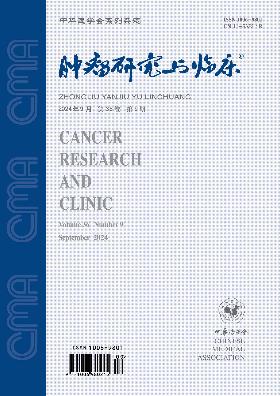移植后淋巴细胞增生性疾病11例临床病理分析
Q4 Medicine
引用次数: 0
摘要
目的分析移植后淋巴增生性疾病(PTLD)的临床病理特征,提高诊断水平。方法收集2008年1月至2018年1月河南省人民医院、北京大学科学中心、北京大学附属第三医院11例PTLD患者的临床资料。采用免疫组化染色、EB病毒原位杂交、荧光原位杂交和基因测序等方法对其临床病理特征和潜在的预后预测因素进行回顾性分析。结果11例PTLD患者中男性9例,女性2例,患者中位年龄18岁(3-34岁)。9例接受造血干细胞移植的患者发生PTLD的中位时间为移植后4个月(2-24个月)。另外2例接受实体器官移植(SOT)的患者分别在6个月和13个月后发生PTLD。淋巴结是最常见的受累部位(9例),1例发生在肝脏,1例出现在鼻咽部位。11例患者中,3例为多态性PTLD(P-PTLD),8例为单型PTLD(M-PTLD)。EB病毒阳性,8例M-PTLD为弥漫性大B细胞淋巴瘤(DLBCL)。荧光原位杂交检测bcl-2、myc、IGH和A20基因,只有1例出现IGH基因断裂,其他病例未发现其他异常。对5例PTLD患者进行了Ig基因克隆分析,其中4例为有基因重排的M-PTLD,1例为无基因重排的P-PTLD。单因素分析显示,年龄(≤18岁)与预后不良相关(P=0.040)。结论PTLD的临床病理特征多种多样,且受EB病毒感染。基因重排有助于诊断。关键词:淋巴增生性疾病;移植;疱疹病毒4型,人类;病理学,临床本文章由计算机程序翻译,如有差异,请以英文原文为准。
Posttransplant lymphoproliferative disorders: a clinicopathological analysis of 11 cases
Objective
To analyze the clinicopathological features of the posttransplant lymphoproliferative disorders (PTLD) and to improve the diagnostic levels.
Methods
The clinical data of 11 patients diagnosed with PTLD between January 2008 and January 2018 from Henan Provincial People's Hospital, Peking University Science Center and the Affiliated Third Hospital of Peking University were collected. The clinicopathological features and the potential prognostic predictors were retrospectively analyzed by using immunohistochemical staining, EB virus in situ hybridization, fluorescence in situ hybridization and gene sequencing.
Results
There were 9 males and 2 females in 11 PTLD patients, and the median age of the total patients was 18 years old (3-34 years old). The median time of 9 cases who underwent hematopoietic stem cell transplantation developing PTLD was 4 months (2-24 months) after the transplantation. The other 2 cases undergoing solid organ transplantation (SOT) occurred PTLD after 6 months and 13 months, respectively. The lymph node was the most common site to be involved (9 cases), 1 case occurred in liver and 1 case occurred in nasopharynx site. Among 11 patients, 3 cases were classified as polymorphic PTLD (P-PTLD) and the other 8 cases were monomorphic PTLD (M-PTLD). EB virus of all cases was positive, and 8 cases of M-PTLD were classified as diffuse large B-cell lymphoma (DLBCL). Fluorescence in situ hybridization was used to detect bcl-2, myc, IGH and A20 gene, and only one case had the gene break of IGH, while other cases didn't find any other abnormalities. Ig gene clone analysis was made in 5 patients with PTLD, including 4 cases of M-PTLD with gene rearrangement and 1 case of P-PTLD without gene rearrangement. Univariate analysis showed that age (≤18 years old) was associated with poor prognosis (P = 0.040).
Conclusions
The clinicopathologic features of PTLD are various and infected by EB virus. Gene rearrangement can help the diagnosis.
Key words:
Lymphoproliferative disorders; Transplantation; Herpesvirus 4, human; Pathology, clinical
求助全文
通过发布文献求助,成功后即可免费获取论文全文。
去求助
来源期刊

肿瘤研究与临床
Medicine-Oncology
CiteScore
0.10
自引率
0.00%
发文量
7737
期刊介绍:
"Cancer Research and Clinic" is a series of magazines of the Chinese Medical Association under the supervision of the National Health Commission and sponsored by the Chinese Medical Association.
It mainly reflects scientific research results and academic trends in the field of malignant tumors. The main columns include monographs, guidelines and consensus, standards and norms, treatises, short treatises, survey reports, reviews, clinical pathology (case) discussions, case reports, etc. The readers are middle- and senior-level medical staff engaged in basic research and clinical work on malignant tumors.
 求助内容:
求助内容: 应助结果提醒方式:
应助结果提醒方式:


